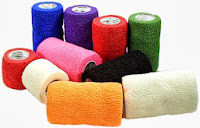 |
| Bagbalm |
Because she is so young, India, as well as other foals, are very prone to injury. Usually being the smallest horses in the field, foals are more likely to be picked on or singled out by other horses in the herd. So what are some common injuries and how are they treated? Well, to start small, bites are the most common injury among horses. To secure their dominance in a herd, a horse will bite another to show that they are in control. A minor bite can just be left to heal on its own, but depending on the size of the bite mark, sometimes an antiseptic lotion is applied to the wound called Bagbalm, which is essentially just Polysporin for animals.
As the injuries get bigger, other precautions have to be made. For example, if a horse gets its leg caught in a barb wire and tears a large gauge in its leg, more intense treatments have to be arranged. Little do many people know, horse first aid kits can be made using common household items.
Step 1: Rinse the cut with cold water, to help relieve any swelling the injury may have caused.
Step 2: With a syringe, squirt an adequate amount of Iodine wash on the wound to kill any bacteria that may have been transferred to the wound from the fence. Iodine wash can be found almost anywhere, as humans use it too.
 |
| Vet wrap |
Step 3: After the Iodine wash dries on the wound, take a female sanitary pad (yes, a pad), take off the wrapper and cut it in half. Pads work fantastic on horse injuries because they are: a) large b) are able to hold a lot of blood, an
d c) they don't stick to the wound when the blood dries and you have to remove it. You then put any type of horse wound treatment medication on the pad (there are hundreds of different types and brands, it's really the horse owner's choice) and place it on the wound.
Step 4: Take some vet wrap (a whole roll is only about 80 cents to buy) and wrap the wound. Change the bandages once or twice everyday, depending on the severity of the gauge.
And there you go! Quick and easy!
All in all, injury is hard to avoid, especially on young rambunctious horses, but with the right care are equipment, healing is quick and easy. Obviously, with bigger wounds and issues, a vet needs to be contacted, but with the small stuff, almost anyone can do it!
www.iherb.com
www.rctech.net
www.americashorsedaily.com














